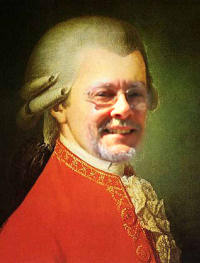A 365-Day Project
"We Are All Mozart"
A project to create
new works and change
the perception of the
music of our time.


 December 4, 2006
December 4, 2006 
This is late -- if anyone is up at this hour noticing. I tripped over my own thoughts and the verbal improv started to come apart...
It should have been time to put a period on this rhythm topic, but there are a few more considerations. One I have been avoiding is the mathematical formulas applied to rhythms. Because music proceeds in time, the ear-brain combination has to assess the incoming stream of rhythmic elements, grasp the pattern, and process them intellectually and viscerally. The simplest formulas (x=x) are ordinary meters. Additive whole-number formulas (x=x+1) give increasing meters. Multiplication and divisions create meters that change so quickly that they have little utility in acoustic music; in electroacoustics, they can transform into pitches, reach the Nyquist point of sampling, produce resulting tones and subtones, and continue with predictable patterns of hoots & honks.
Regular geometric shapes and arbitrary shapes can be used for rhythmic patterns, but remain simple iterations -- perhaps speechlike as yesterday's Polansky example, but ultimately either arbitrary in sound or repetitive groups that are perceived at first as random. Nonpop music is built on expectation and relistening, though, so even the statistical noise of Xenakis's Bohor I becomes familiar and expected over time. (Tuck into the hat inevitability here; it will circle 'round.) Serial music is difficult for many experienced listeners to grasp quickly because in its pitch and rhythmic democracy, if you will, the direction, discrimination, relative significance and stresses are minimized in the underlying structures, while other aspects -- textures and colors, for example -- become more important. Without serialism, Klangfarbenmelodie has little influence on the listening process. (As evidence I offer RatGeyser, whose entire opening is Klangfarbenmelodie, but within a pulsed and tonal structure. The pulse and tonality remain so important that the composition is enormously difficult to perform.)
Having dismissed serialism in the stroke of a single paragraph above, then, I am free to move on to a rhythmic concept with possibilities: fractals. To reduce fractals to absolute bone simplicity: You act on a source, combine the results to become a new source, and act on the new source in the same way. (Did you miss fractals in elementary school? I did. Math didn't have them yet, so catch up with the children.) Fractals produce beautiful images and emulate the patterns in nature, but as rhythmic sources, they suffer from the curse of math: it's not assessable in real time. Like Carter's metrical modulation, it can be sensed, but it is inherently acoustically unstable and destructive of the characteristic source of rhythm itself, the natural cycles. (Some consider fugues to be fractal; that sounds bogus to me.)
I tread carefully here. Such processes are art that bucks biology -- one of art's purposes, in that it reveals what we do not know or, if we do know it, take for granted. On the other hand, Seneca said, "Omnis ars naturae imitatio est." All art (and yes, he was talking about medicine) is in imitation of nature. But... oh, fractals look like nature, at least in their visual context, in broccoli and the coast of Norway and the waving grain in the field. So such elements are like art, not like art, like biology, not like biology. If there is a problem with calculated rhythms, it is not their artificialness, their artifice or their art, but their failure to step across the threshold of perception. Fractals, serial rhythms and isorhythms all suffer from the failed triumph of mind over body.
It is understood, falsely or not, that the particular appeal of music is its expressiveness. The calculated rhythms are precise, but to refer again to biology, we are not so much fractal as chaotic. The human system is so complicated that we speak of imperfections and abnormalities and anomalies that are in fact the end result of chaos impinging on DNA (itself a very interesting source for fractal images and pitches). Our search for perfection is gratified more by imperfection -- a look at some of the sterile results of modernist architecture, design, sculpture and (yes) music suggest that perfection is simply uninteresting. The failure of my own Dripworks was a hard lesson; its perfect basis in a Markov chain was quite simply dull music. From that I learned that the inclusion of imperfections in the generation of music -- acoustic or electronic -- struck deeper inside us than cleanly hewn gems of composition. If I can be forgiven a touch of Mozart, the third movement of the tenth serenade for winds (K.361) takes a straightforward piece of regular homophony and splatters over top of it a very flexible and sinuous and thus completely uncharacteristic (in terms of rhythmic regularity) oboe solo. The 'perfect composer' uses imperfection to create his human effect.
Could it be that the formulaic approach to rhythm has substance once it is undermined? I'm not sure; it hasn't been around long enough to arise from precision, but there are two additional cases to be made.
Larry Austin wrote a piece entitled Square about forty years ago. The piece was partly graphical in that staves were intersecting at ninety degrees and the notes were performed by size. The notes were by all visual accounts placed on a regular grid, but the horizontal placement was affected by the vertical placement on the intersecting staff, making a given sound 'hot' or 'cool' depending on how it fell. The second thought was a reaction to an earlier comment in this series about the decline of poetry. A composer wrote that in conversation he was reminded of the rise of rap "in contrast to the decline of nonpop poetry." It was very incisive, as even though rap lyrics, like rock harmony, are Nineteenth century and very modular, rap's major shift is the internal 'speechifying' of the rhythm into slightly irregular groupings. That aspect makes it more like the late medieval motet, with its rhythmic disengagement between points of stability. This gets our interest.
The first sentence I wrote about this was, "We are creatures of malleable regularity." In returning to rap, Austin, and chaos, I believe that it makes more sense. Mathematical precision contains neither the unexpected nor the malleable, and thus contains nothing that is memorable. We search unconsciously through images for points of focus, something to remember; and through music we listen for the hook. What is exciting and what is gratifying combine to make a perspective of transcendent comprehension.
Maybe there's more. Here's what I am thinking about for tomorrow: Rhythmic nonharmonic language and two-dimensional rhythms ... composing the woodpile, so to speak.

The cactus in the window is not quite fractal at this magification, but stand back...